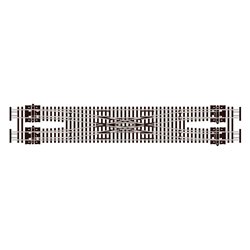Static grass puffer bottles work by manually charging model grass fibres with static electricity. When the charged...
No products
Product successfully added to your shopping cart
There are 0 items in your cart. There is 1 item in your cart.
Search Tips
Is Code 55 track a better option than code 80 track for my first N Gauge layout?
Code 55 and Code 80 are different types of model railway tracks, both are available for use on an N Gauge layout but they both have different characteristics.
Code 55 track has a finer rail profile and smaller spikes or tie plates than Code 80 track. This results in a more realistic and 'in scale' appearance and is often preferred by railway modellers who prioritise realism in their layouts. Additionally, it is worth noting that Code 55 track is also slightly narrower than Code 80 track, which makes it easier to fit into tight spaces.
Code 80 track, on the other hand, is more robust and durable than Code 55 track, making it a good option for layouts that will be frequently handled or transported. It's also slightly more forgiving than Code 55 track, making it easier to work with for beginners. For many modellers, the immediate visual differences between the codes are not always easy to spot and so given its strengths, Code 80 track is a pragmatic choice for many modellers.
For a first N Gauge layout, it may be easier to use Code 80 track as it's more forgiving for beginners but if realism is your primary concern, Code 55 track may be the better option. Both have their advantages and so inevitably the decision to opt for one code over another is a matter of individual preference.
There can be configuration issues when differing coded layout elements are mixed together. Therefore, before settling on a particular code for your layout, it is important to check the compatibility of the track type with the rest of the components you're planning to use, such as power supply and rolling stock.
Click here to receive the tips weekly in your mailbox. You can unsubscribe at any time.










